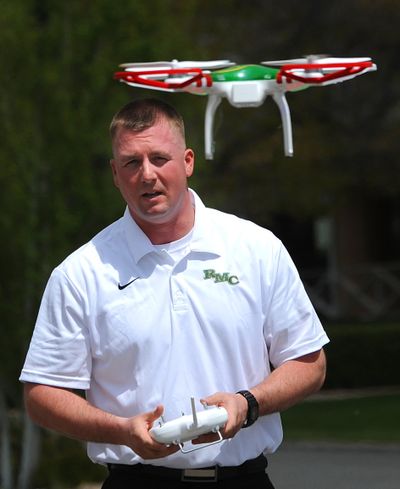Rocky Mountain College adds drone training class

BILLINGS – The future of flight may feature more unmanned aircraft hauling cargo, according to Rocky Mountain College aviation professor Scott Wilson, so he’s helping to train pilots how to operate such unmanned aerial systems, or UASs.
“Many of my colleagues say the last fighter pilot has already been born,” Wilson said on Monday during a discussion of the class work.
The class was added to the Billings college’s aviation program this spring, joining what has become a quickly expanding interest in the systems for a variety of applications ranging from agriculture to real estate and search and rescue.
For example, in Japan, Wilson said, 90 percent of the crop dusting is done by UASs, which can range in size from fist-size toys powered by batteries to full-size aircraft used by the military.
“We figured we had to get something going here at Rocky,” Wilson said.
A few other colleges, such as the University of North Dakota, already offer degrees in unmanned aircraft systems.
Wilson said when he began looking into offering a course, he couldn’t even find a textbook until just recently. The text, however, mainly focuses on the technology and regulation environment revolving around UASs.
Yet with some certification, such as that being offered by Rocky, Wilson foresees aviation graduates stepping into jobs that pay $75,000 to $125,000 a year.
“Our objective for students is to have a working knowledge of the UAV environment,” he said, using another phrase for the aircraft.
Right now, that environment is pretty hazy thanks to a lack of regulation by the Federal Aviation Administration, which is supposed to have regulations out by 2015. But Wilson said the framework for safely operating UASs has already been outlined: Don’t fly them at altitudes above 400 feet, avoid conflicts with other aircraft and stay at least 5 miles away from airports. If UASs are operated above 400 feet, Wilson said, the pilots should have some sort of certification.
Fear of lawsuits has kept television stations in “limbo land” for fear of being prosecuted by the FAA if they run any video captured from UASs, said Jon Stepanek, KTVQ’s news director.
But Wilson said the FAA is like the highway patrol cop pulling over the blatant speeders: the agency will only go after the most egregious violators. Operators who aren’t thumbing their noses at the FAA or embarrassing the agency won’t be prosecuted, he said, partly because the FAA doesn’t have enough people to go after everyone.
Cameras capable of shooting still photos or video images can be mounted to the UASs, making them useful for photographers and videographers. The Stillwater County Sheriff’s Department recently purchased a UAS that has an infrared camera that can be used to detect the thermal signature of a human during search and rescue operations.
“You get 10 times the surveillance for one-tenth of the cost,” Wilson said. “That’s a huge savings.”
Because of the video and photography capability provided by UASs, Wilson said, surveys have shown the public is skeptical of or concerned about the usage of the aircraft.
That’s also one reason the industry never calls them drones – which carries a negative military connotation. He said the biggest problem is balancing the rights of citizens to privacy with commercial operators conducting business.
“Like any tool, if it’s abused, it will cause social problems,” Wilson said.
Conservative predictions are that there will be 10,000 UAS operators within the next five years. The problem is that the UAS industry is traveling at “Mach 1,” Wilson said, while the FAA is trying to catch up in an automobile.
Newly graduated Rocky senior Ryan Rojeski helped form the program, which has six small UASs. He hopes to become a Navy fighter pilot and transition into the space program. Rojeski said there will always be a need for pilots, as well as for operators of unmanned aerial systems.
Rocky offers majors in aeronautical science and aviation management, as well as a minor in aeronautical science.
Student Joe Mutchler, who served for 13 years in the Air Force, also helped develop the Rocky program.
“I think the opportunity Rocky has given students is awesome,” Mutchler said.
“There is a growing interest in this, not only in the school, but in the community.”